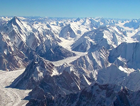Unlike nearly all other high-altitude glaciers across the globe, glaciers in the Karakoram mountain chain, part
 of the Himalayas, are not melting and are even expanding in some areas. This so-called “Karakoram anomaly” has puzzled scientists for years, but now a team of researchers has offered an explanation: While rain from warm summer monsoons tends to melt mountain glaciers in other parts of the Himalayas and the nearby Tibetan Plateau, the location and height of mountains in the Karakoram chain, which runs along the borders of China, India, and Pakistan, protect the area from this seasonal precipitation. Instead, the mountain chain receives most of its precipitation in the form of winter snowfall, according to findings published in Nature Geoscience. The study suggests that the Karakoram glaciers are likely to persist until 2100, but not long after, if global warming continues at its current pace.
of the Himalayas, are not melting and are even expanding in some areas. This so-called “Karakoram anomaly” has puzzled scientists for years, but now a team of researchers has offered an explanation: While rain from warm summer monsoons tends to melt mountain glaciers in other parts of the Himalayas and the nearby Tibetan Plateau, the location and height of mountains in the Karakoram chain, which runs along the borders of China, India, and Pakistan, protect the area from this seasonal precipitation. Instead, the mountain chain receives most of its precipitation in the form of winter snowfall, according to findings published in Nature Geoscience. The study suggests that the Karakoram glaciers are likely to persist until 2100, but not long after, if global warming continues at its current pace.

Baltoro Glacier in the Karakoram range